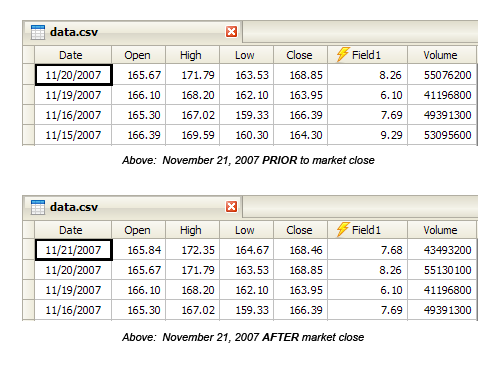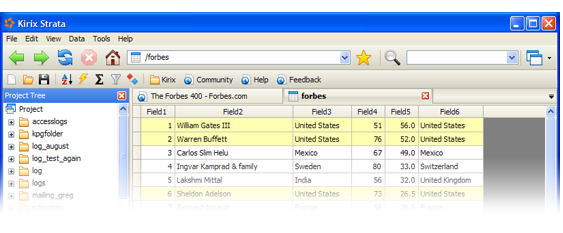Kirix Strata Beta 6: Introducing “Data Bookmarks”
Wednesday, November 21st, 2007
We've got the new Strata beta 6 ready and available for download so you can play with the new features before the legendary tryptophan coma kicks in tomorrow (at least for our U.S. readers).
We've got a couple big features that we've added to this beta:
Data Bookmarks
Ever since we've seen web data transformed into nice, usable tables, we've longed for the ability to a) link to the data and b) refresh it.

Today, we've taken a big step in this direction. You can now link directly to data tables on the web. The two formats we support in this version are RSS and CSV, but more will follow in the coming weeks.
So, for a quick example, copy the following URL and paste it into Strata's URL bar:
http://finance.google.com/finance/historical?q=NASDAQ:AAPL
Google Finance provides historical stock information, in this case for Apple. This website also provides a “Download to Spreadsheet” link that, if clicked in Strata, will open up the CSV file in a table. In previous beta versions, you couldn't link to these tables directly. However, in this version, you'll see that it is just a regular ol' URL waiting to be bookmarked:
http://finance.google.com/finance/historical?q=NASDAQ:AAPL&output=csv
And, with regular ol' URLs, you can do things like open them up tomorrow and view updated data. Or, you can share the links with friends and co-workers. You can also do things like create a calculated field that will automagically recalculate tomorrow when the data changes.
We've got these data links up and running for RSS feeds too, say:
http://www.digg.com/rss/index.xml
However, we don't have the saved calculated functionality in for RSS just yet. Also, right now the “refresh” button in the toolbar isn't hooked up to these links, but it will be soon.
Because URLs are such a simple concept that everyone understands, we envision that this type of thing could be quite useful — particularly in a corporate environment. Instead of creating a daily CSV/TXT extract that must constantly be downloaded and loaded into Excel/Access on the desktop, an analyst could just create a data link in Strata and click the bookmark each time they wish to access the data.
Got other ideas for how you might use them? Please let us know what you think.
Automatic Update Notices
We've added a feature that will provide a notification of a new beta version without you ever needing to leave the comforts of your own Strata. Hopefully this will more efficiently keep everyone up to date with the latest and greatest. This doesn't mean you should unsubscribe to this blog though. ![]()
Other Features/Fixes
- The Bookmarks Toolbar continues to get enhanced. For instance, now you can drag links from the URL bar directly to the link bar, just like you'd normally do in Firefox or Internet Explorer.
- Downloads from the web are now hooked up to the Job Manager.
- If jobs are running, you can now stop them with the Stop button (or will cause the job manager to open if there are multiple jobs running).
We really appreciate all the comments and feedback. Please keep it up, it's fantastic!


 If you haven't checked out what the fine folks at
If you haven't checked out what the fine folks at 
 I'm slightly (fashionably?) late to this party, but I just came across a new website called
I'm slightly (fashionably?) late to this party, but I just came across a new website called